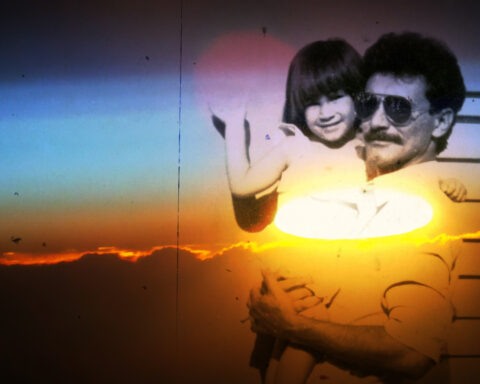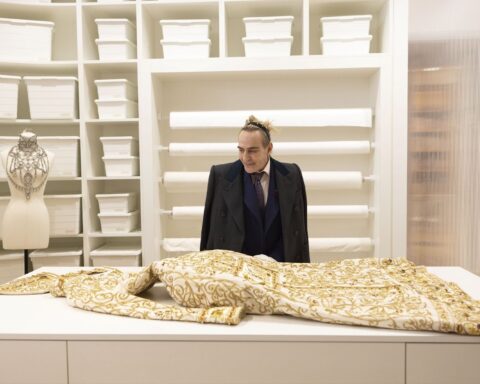Every year Hot Docs gives us a glimpse of documentary production from Quebec. The three films considered here stand out for their strong content and the very personal visions of their directors.
Bà nôi (Grand-mother) is directed by Khoa Lê, who was born in Vietnam but has lived in Montreal most of his life. He spent a month in Vietnam during the Vietnamese New Year celebrations, visiting his 93 year-old grandmother, an amazing, strong-willed and quite authoritarian character who bosses everyone around; she is funny and endearing in her vulnerability. Her leitmotif is the question of her grandson’s marriage, given that he is the last male of the family. This varies from subtle hints to outright rants in which she sees her family being doomed forever, losing everything it has if the lineage is not continued through a marriage—and most certainly not a marriage to a Western girl!
The portrait of Lê’s grandmother is definitely infused with a certain ethnographical study. He adroitly explores traditions and rituals that are steeped in age-old superstitions. They are presented with care and respect, thus defusing any comic reaction on the part of a western audience. Indeed, we learn that Lê owes the fact that he is alive to a premonition. When he fell sick before boarding the boat on which his family planned to flee the country, his father saw this as a bad omen and decided not to leave. Another family member took their place and was never seen again when the boat sank.
It is strange that Bà nôi is included in the World Showcase section, rather than in Hot Docs’s Canadian Spectrum. This film, though set in Vietnam, is full of elements that bring us back to Montreal, with the theme of exile as a strong undercurrent throughout. Khoa Lê brings this out through messages left on his answering machine. They come in all languages, from friends and family members, and they clearly underscore the sense of distance and pain of being away from loved ones. Lê demonstrates a strong talent, both as a storyteller and an amazing visual artist on a journey that mixes tradition with strong contemporary elements.
With Alphée des étoiles (Alphée of the Stars), Hugo Latulippe has moved from political (What Remains of Us) and environmental subjects (Bacon, the Film) to a much more personal subject. His film is a cinematographic letter of love and hope to his five-year-old daughter, Alphée, who suffers from Smith-Lemli-Opitz syndrome. This genetically-transmitted disease slows down the neurological and muscular growth of the child. If at first glance Alphée looks like a happy little girl full of life, we see later that she suffers from a severe speech impediment. When it comes time for her to start school, the authorities recommend that she be placed in a school for the intellectually challenged. Her parents decide to delay the start of her education by one year. Their sixth sense tells them that Alphée can make it, but away from their busy schedules and the noise and chaos of a big city.
They move to a quiet village in Switzerland, where they spend most of their time caring for and working with Alphée to improve her speech and comprehension. She fights through life and makes valiant efforts to learn words and numbers. Nothing seems to daunt her. This film has a poetic tone, not only because of its bucolic setting, but also due to Latulippe’s own narration, which features an elegant and musical choice of words for Alphée to understand. On a technical level, Latulippe conveys the minute sounds of the forest as he imagines how his daughter hears them. As a contrapuntal element, he shows her yelling at the trees, asking for Tintin to come down from them or hoping to see the Lion King appear with some of his feline friends.
But there is also a latent undertone: the constant fear of the future for the parents of a child struck by a rare illness for which there does not yet seem to be a cure. There is also the frustration of not seeing quick progress in Alphée’s condition, combined with Latulippe’s own difficulty adapting to a much slower pace of life from both a personal and professional perspective. Latulippe cleverly avoids pathos and never dwells too long on the difficulties and the challenges Alphée and her parents face. What we take away from this film is Alphée’s playful, smiling face. Alphée des étoiles is a breath of fresh air that proves how keen and sensitive Latulippe is as a filmmaker.
In 2009, 70 percent of the Rupert River’s headwaters were diverted towards five power stations in the James Bay area, where Hydro-Québec is building several dams to collect electricity to be sent and sold to the South. Nicolas Renaud immediately makes his point with this introductory statement in his documentary La nouvelle Rupert (Brave New River). The title is stronger in English, because it better conveys the notion of struggle for the river’s survival since its total transformation in 2005. The Rupert River was one of the first major waterways used by the Voyageurs. The Hudson Bay Company’s first trading post was established at its mouth in 1668, which in time became Rupert House. For centuries the Cree have depended on this river for their livelihood, but now all of that has changed: the Rupert River has gone from a daunting and powerful torrent to a weak and tranquil waterway. Some areas, including sacred Cree burial grounds, were flooded when it was diverted from its original course. One of the most important issues relates to the cisco, or “whitefish,” that can no longer swim upstream from the ocean to spawn in the clear water stone weirs of the Rupert River during the summer. The cisco is one of the Cree’s main food staples. Although plentiful in the past, now only several hundred make their way to the Rupert River each year.
Experts from Hydro-Québec, who work closely with the Cree, study the problem and propose solutions, whose outcomes sometimes leave the Cree both amused and perplexed. Renaud allows for points of view from both sides: representatives of Hydro-Québec and members of the Cree community, who depend on the survival of the Rupert River. Renaud has captured the beauty of the landscape, juxtaposing images of the “before” and “after,” all the while conveying the concerns of the Cree population. This film has moments of humour that bring out the sadness, anguish and the Cree population’s sense of powerlessness. Renaud’s choice to remain neutral and avoid controversy leaves us hoping for a more personal and involved point of view from this otherwise thoughtful and talented filmmaker.
These three films demonstrate that Quebec has strong documentary filmmakers, each with a clear voice and personal vision. Some, like Nicolas Renaud, are inspired by the likes of Pierre Perrault and Michel Brault, listening and letting their subjects speak for themselves. Khoa Lê is more of the younger generation, not hesitating to divert from a traditional form to a more experimental style and mingling both quite astutely. Regardless of Hugo Latulippe’s style, his film stands out because of how delicately he deals with a very personal issue into which he infuses an array of emotions, while still keeping the lid on them so the narrative never becomes over-dramatic or trite.








